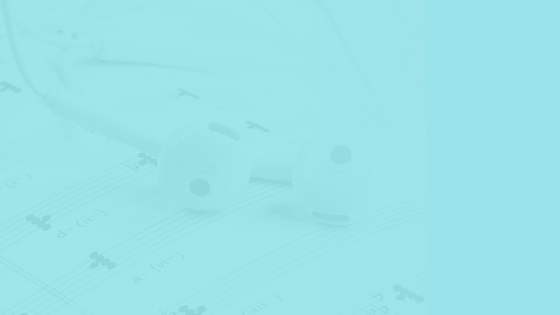
4 Essential Fundamentals of Music You Need to Start Playing the Piano
This 4-day bite-size free course is designed to help you get started on this journey on solid ground.
JOIN THE FREE COURSEThe One Chords Progression You Must Know to Play Tonnes of Songs (Beginners)
Chords progression is an awesome thing. I’m not sure about you, but I luvvvvv pop rock and pop songs! If you enjoy these too, then this post is totally for you whether you’re a beginner or you’ve already started out.
If you prefer to watch this lesson, scroll all the way down for the video.
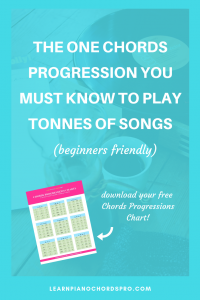
Firstly, I want to clear any thoughts about how piano chords progression is a complicated, complex thing because it is not. I’m gonna explain to you everything you need to know about it.
But most excitingly, I want to show you THE one chords progressions that you can use to play lotssss of songs!
But first…
What is chords progression?
Now, the chords progression is a series of chords that repeats or changes in a musical piece. There can be one or more chords progressions that occur in a musical piece.
Many songs are written based on the same chords progressions which makes it easier to learn a piece of music and it is also easier for you to play a song in different keys.
Below is a snapshot of the chords sheet for the song “Say You Won’t Let Go” by James Arthur. It’s one of my fav. 😛
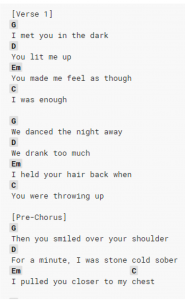
This song is written in the key of G major. Noticed that the chords series G major, D major (sus4), E minor and C major keep repeating themselves throughout the song?
This my friend, is chords progression. Get your free copy of the most commonly used chords progression below.
How is chords progression formed?
Here comes the nitty-gritty part about piano chords progression.
Chords are basically derived from scales. For example, the chords C major, A minor, G major or F major are formed from the scale of C major.
1. Each note of a scale can be used to form chords
Here is the scale of C major and each note in this scale can be used to form chords. Check it out in this video below.
If we were to write them down, each of these notes of the scale C major can form different chords like this.
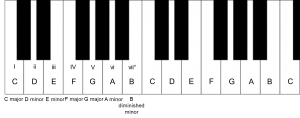
There are 3 major chords that can be formed and they are denoted with a Roman Numeral Capital Letters. And there are 3 minor chords that can also be formed and they are denoted with a small cap Roman numerals.
And finally one diminished chord. Diminished is one funny-sounding chord. Try it and see how you feel about it. This is denoted with a small cap roman numeral with a dot symbol.
Now, all of these chords that you see here fall under the same family of the key C major because they are formed from the scale C major. And a major key always starts with a major chord. With this example, the key is C major, so the first chord is C major.
Here are some examples of chords formed under their respective major keys.

On a minor scale, here I’m using the scale of A minor as an example. Each of the notes of the scale can also be used to form chords.
If it is written down, a minor scale will also produce 3 minor chords, 3 major chords, and a diminished chord but the location of the major, minor and diminished chords are different from the chords formed by a major scale.
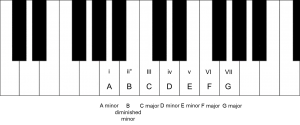
Now, a minor scale or key will always have a minor chord as the first chord. For A minor, the first chord is A minor which is a minor key.
Similarly, all of these chords fall under the same family of the key A minor because they are formed from the scale of A minor.
Here are some examples of chords formed under their respective minor keys.

2. Series of chords that repeats or changes
Now, let’s look at how we can use the family of chords in what is known as the chords progression.
Just to recap, the piano chords progression is a series of chords that repeats or changes in a musical piece.
Many songs are written based on the same chords progressions which makes it easier to learn a song and it is also easier for you to play a song in different keys if you know the chords progression of the keys.
Earlier on, we’ve looked at how chords are formed with the scales and how they fall under their respectively family of keys.
Chords progression can also be explained as chords from the same family of key arranged into a series of chords, so for example, one of the most common ones is I- V- IV.
Now, let’s say a singer said, hey I wanna try out this new song using the key of C major and the chords progression is I-V-IV.
Then the pianist must know, what she means is that the song is played with the chords C major, G major and F major throughout.
This is when knowing the family of chords at your fingertips comes in handy. You know immediately what are the chords in the key of C major that formed I, V and IV.
And if the singer says, “Oh, the key of C major is too low for me, let’s try it using the key of G major”.
Then the pianist would know what are the chords that fall under the family of G major and chords that make up the chords progression I-V-IV.
Using the piano chords progression I-V-IV is just one of the many chords progression that you will encounter.
If you haven’t, get your free copy of the most commonly used chords progressions chart below.
You can create any chords progression in any key and change the order of the chords to suit your liking if you are writing a song.
Or you can just play tonnes of songs that you love with the same chords progression which I’m about to show you now.
The awesome chords progression I – V – vi – IV
Here comes the fun part! I really want you to learn this very chords progression because so many wonderful songs are written in it.
I want you to get this chords progression and immediately be able to play most of the songs you love with it like TODAY!
Here are some of the many songs written in this chords progression:
- 20 Good reasons by Thirsty Merc
- Say You Won’t Let Go by James Arthur
- A Letter to Elise by The Cure
- All Too Well by Taylor Swift
- Wherever You May Go by The Calling
- Always on My Mind by Brenda Lee
- Someone Like You by Adele
- Beast of Burden by the Rolling Stones
- Fucking Perfect by Pink
- California King Bed by Rihanna
- Cryin’ by Aerosmith
- Demons by Imagine Dragons
- Far Away by Nickelback
and the list goes on…
I want to show you how you can play some of these songs with this piano chords progression and you’ll see how by…
- playing the bass note of the chord could make a significant effect on the song.
- changing the rhythm of the chords and bass notes would give a different feel or vibe to a song.
- changing how to play the chords (either by triad chords or broken chords) would change the mood and emotion of a song.
- adding passing notes or notes between chords would make the chords sound richer and more interesting.
In this video, I’ll give you two perspectives on how to play them. With my right hand, I’ll play either the melodies or just chords.
Usually, if you play chords with your right hand, you’d sing the melody or accompany another instrument that plays the melody.
Check out how I used just these 4 chords to play 5 different songs in this video. I kinda got too excited that my keyboard got tilted towards the left in the end. *LOL*
There you have it! I hope it is clear to you now what chords progression is all about and how easy it is to play so many songs with just one chords progression I – V – vi – IV.
I hope you can give it a go and tell me about it in the comment box below. Have fun and keep playing!
Watch this lesson in the video below.
About The Author
Kaiyen Goh
Kaiyen helps music lovers and beginners who want to play the songs they love and create the songs they’ve always dreamed of writing. She also created a free course called “4 Essential Fundamentals of Music That You Should Know to Play Piano with Piano Chords”, where she aims to help people with no musical background to start playing the piano on solid ground.
Related Posts
Unlock the Secret: A Comprehensive Guide to How to Play Piano Fast Without the Overwhelm
Looking to learn how to play the piano by yourself? You’re at the…
THE 4 MUST-KNOW PIANO CHORDS FOR BEGINNERS
If you’re a beginner, I’m sure you’re excited to…

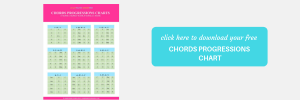
GRACIAS,ESTOY MUY AGRADECIDO POR TUS BONDADES, HACE ALGUNOS MESES ATRAS ME ENVIASTE UNA TABLA CON 24 ACORDES MAYORES ,MENORES ,SOSTENIDOS Y BEMOLES ,ESTOY APRENDIENDO ME CUESTA CARO,PERO TENGO QUE APRENDER UNA VEZ MAS,GRACIAS DAMA ESPERO NO FALLARTE.